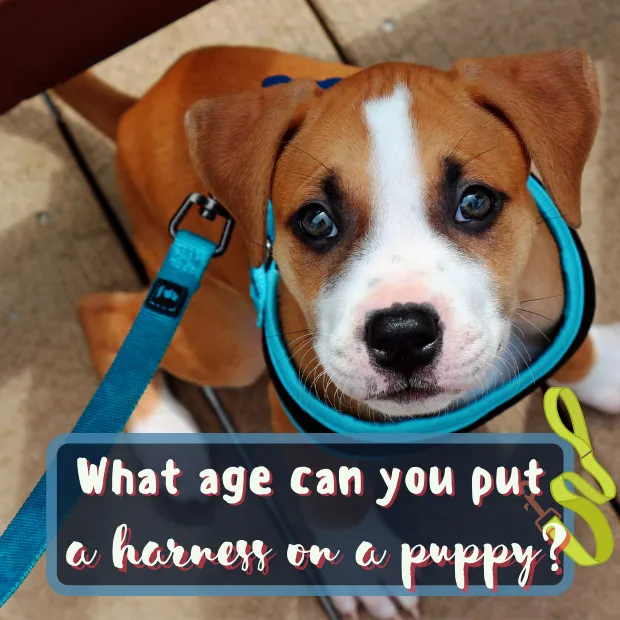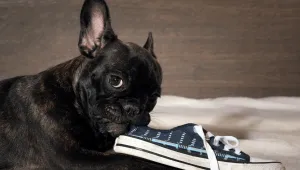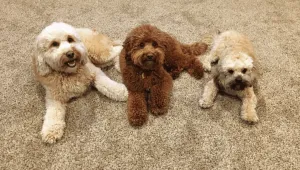If you’re interested in learning what age can you put a harness on a puppy, the benefits of harnesses over a collar and how to go about introducing your puppy to the harness, then read on.
Using a harness on your dog is strongly recommended for safety and health. Puppies and adult dogs frequently pull too hard on a collar, almost strangling themselves in the process.
Why would you want to use a harness instead of a collar with your puppy?
There are several reasons why harnessing is the ideal solution.
Continue reading to learn all about puppy harness training, the best age for using a puppy harness, and why it’s preferable to attaching a leash to a collar.
Table of Contents
ToggleContents of this article:
- What age can you put a harness on a puppy?
- What’s the best type of harness for a puppy?
- Benefits of using a harness.
- How do you get a dog to like a harness?
- How to start training your puppy to wear the harness.
- Should dogs wear their harness all the time?
- Summary.
What age can you put a harness on a puppy?
The best time to start using a harness is when your puppy first comes home from their breeder.
You can introduce it as early as eight weeks old, but bear in mind they grow quickly and you’ll want to make sure you get a good fit in the right size for them.
When should you begin harness training your puppy?
Start harness training your puppy as soon as possible practically from day one!
What’s the best type of harness for a puppy?
There are lots of different materials and cool colors to choose from.
Some are designed with padded mesh material for comfort and durability.
Many have materials with reflective qualities so you can been seen in the dark.
Some are made with neoprene padding which is durable but make sure it doesn’t make your puppy too hot.
The more coverage it has, the more important it is that it is lightweight and encourages airflow.
There are several harness styles available on the market.
A Y-shape style.
This has a Y shape at the front, which narrows as it goes between the dog’s front legs.
It is the most ergonomic type, and allows for the most freedom of movement.
Many Y shaped styles have a front clip which helps prevent pulling on leash. These discourage pulling by steering them in the direction you want to go.
They’re perfect for puppies who are still learning how to walk on a leash, as they provide more control and keep them from pulling you around.
A H-shape or step in style.
This type is put on like a pair of pants, with your dogs front paws stepping into the leg holes. Once it’s on, you clip the closure around their back.
This type is not as comfortable or ergonomic as a Y shape, but they tend to be less expensive so can be an affordable choice for puppies.
There’s no struggling to get it over their head but they can be fiddly to get on a wriggly puppy.
A tactical style.
This type is more commonly used for working or service dogs.
It goes over the head with a strap that goes across the front of the chest and a strap that goes under the ribs around your dog’s body secured with a sturdy clip.
This type can impede the dog’s shoulder range of movement, and they can be very easy for dogs to back out of if they are not correctly fitted but they are easy to put on.
An example of this type is the Julius k9.
Here’s a great video demonstrating how different types of harness can change a dog’s gait.
How to choose a harness.
You will want to find a harness that is the right size for your puppy.
Measure your puppy before you buy, the size options are usually based on the dog’s measurements.
Most styles are adjustable, so you can make it fit your puppy well.
If it fits correctly, you should be able to fit just two flat fingers between your puppy and the harness.
It will be easy to keep it clean if you buy a harness that is machine washable
Keep the labels attached so if the harness doesn’t fit, you can return it and exchange it for a different size.
If it fits and you are keeping the harness, you can start training your puppy right away.
Benefits of using a harness.
Are harnesses bad for puppies? Is a collar or harness better for a puppy?
Using a dog harness is actually better for puppies than using a collar.
Dog collars can damage a puppy’s throat, but a harness is a great tool for walking your puppy and training them to walk on a leash or lead.
As a qualified trainer, I would always recommend a harness as the best way to leash train a puppy. This is because collars can injure a puppy’s neck.
Puppy owners should not attach a leash to a collar on their puppies when they are young or when they grow up.
Even older dogs can still get injured if they jump or lunge.
The throat of a dog is one of the most vulnerable regions in its body, yet it is frequently neglected.
Pressure from a leash and collar may limit blood flow and nerve pathways, causing or exacerbating a variety of physical problems including:
- Eye problems caused by intraocular eye pressure
- Collapsed trachea
- Syringomyelia
- Brachycephalic obstructive airway syndrome
- Sensitive throats (e.g. after Kennel cough)
- Thyroid disorder
Pain or discomfort in any form raises your dog’s arousal levels, which has an immediate impact on their emotional wellbeing and behavior. This can also lead to leash reactivity in dogs.
If you are trying to train your puppy to walk on a leash, it is important to use a harness instead of a collar.
This will help you have more control over your puppy and prevent your pet from hurting themselves by tugging forcefully if they get startled.
Smaller dogs are more delicate than larger dogs. They may get harmed or injured their necks if they struggle against a collar all of a sudden.
Using a harness to train them is an extremely safe method since the pressure is applied to their chests, which is the strongest part of their tiny bodies.
When your dog is wearing a collar, you need to be careful that he or she doesn’t choke. This can happen if the dog pulls against the leash. With a harness, your puppy will not be harmed if this happens.
Puppies can slip out of a collar easily if they pull backwards. They’re far less likely to slip out of a harness that fits them correctly so this is a more secure option.
In addition, using a harness instead of a collar is better for puppies because it is easier to control them and your puppy can’t get so tangled up in the leash. They are less likely to start ragging or biting on the leash.
There are many advantages to using a harness when training your puppy. It really is the best option from a safety and security point of view.
Walking your dog will be a lot simpler; you’ll have greater confidence that he or she will be secure.
How do you get a dog to like a harness?
If you want your dog to like their harness, you need to introduce it correctly. Let them interact with it and get comfortable seeing it around.
Always go at a pace your pup can handle so your pup accepts the harness and do not force it on them if they are scared.
How long will harness training take?
It may take a couple of hours or a few weeks for you puppy to accept the harness as all dogs are different.
How to start training your puppy to wear the harness.
Introducing the harness.
The first step is to put on the harness and test it out. Make sure that it fits well and is comfortable.
Choose a time for your training session while pup is completely relaxed and happy.
You can play with your dog a little bit before attempting it for the first time, so they’re not full of energy.
Then, when you’re ready to start, show the harness to your pooch.
Set it down on the floor and let your puppy smell it.
If your dog looks at, moves towards or sniffs the harness, say “Good” and give them a training treat.
It’s important to start teaching them that being interested in the harness is a good thing to create a positive association.
Make sure they are comfortable with the harness just touching them before going further, we don’t want pup feeling worried.
If your pup likes to chew things, its important to be quick with rewarding them for taking an interest but before they put their mouth on it! You don’t want them thinking this is a fun toy to be destroyed!
When you put it on, it’s important not to frighten your puppy since this will make it harder for them to accept the harness.
Whenever you want to put the harness on your puppy, keep the sharp end busy with some sprinkled treats on the floor for your pup to eat and this will help your puppy learn it is not something to worry about.
If you have to put the harness over your puppy’s head, put the neck hole over your wrist, poking your hand through holding treats at their chin height to feed your pup as you are moving it over their head.
Have more treats on hand and be sure to reassure your puppy with lots of praise as you snap the buckle and adjust the straps. Try to dampen the sound of the clips if you can.
Spend time playing with pup whilst they have the harness on for a short while and then take it off. You might try this for a few days until your puppy barely notices they are wearing it.
To speed up the process of them accepting the harness you can also put it on just before their mealtime.
Here’s a great video on harness conditioning by British dog trainer Chirag Patel.
Clip on the leash.
You can begin using the leash after you are sure that your puppy is used to wearing the harness. Simply sit in a chair and hold the leash for the first time you snap it to the harness.
When your puppy reaches the end of the leash, this might confuse them, but you can call them and reward them for coming towards you.
Take some time to show your the puppy that the harness restricts their movement and this will make it easier when you go outside.
Start leash training inside the house.
You can now begin practicing walking your puppy around the house after they are accustomed to the harness and leash and they understand that it will restrict them.
Check out the post on loose leash walking with the 300 peck method for the next steps.
Take your training out to the yard or garden.
Once you’ve mastered leash walking in the house, you can take your puppy out to the yard and practice some more. Make sure you have plenty of high value rewards to hold their attention.
Expect your pup to find it much more distracting in this new environment.
Go for a short walk.
You’ve been practicing a lot with your puppy, so now it’s time to venture out on the pavement or sidewalk.
Remember that in a new environment, there will be many distractions, so be sure to have lots of high value rewards. This is where your training can help you and your puppy stay focused.
The harness will be familiar to your puppy, and they will already understand what you want from them.
When your puppy gets distracted with fresh sights, scents, and sounds, use some treats to get their focus back.
Should dogs wear their harness all the time?
It’s okay if your dog wears it at times other than walks provided your dog seems comfortable in it and is not bothered by it.
It’s best to not leave your dog unsupervised when wearing a harness, particularly in a crate as they may snag it on something and panic if they get stuck.
Summary.
You can start using a puppy harness when your puppy is any age. As soon as you bring your puppy home, start working with the harness.
It’s good to introduce the harness before you go for a walk. Your groundwork will pay off and make your first walk a much easier experience.
When you take the time to teach your puppy about the harness this way, you will be able to build on their experiences at each level.
It is very important to spend time training your puppy to accept their harness so that they are safe and happy outside.
Use encouragement and lots of food as a reward to ensure that your puppy will continue to develop the good habits you want him to have. Have a great time together outside.
I hope this article has helped you understand the best age for training your puppy to walk using a harness and that you feel confident in the steps you can take to make this process easier for both you and your pup.
Check out this post on what to do if your puppy won’t walk.







